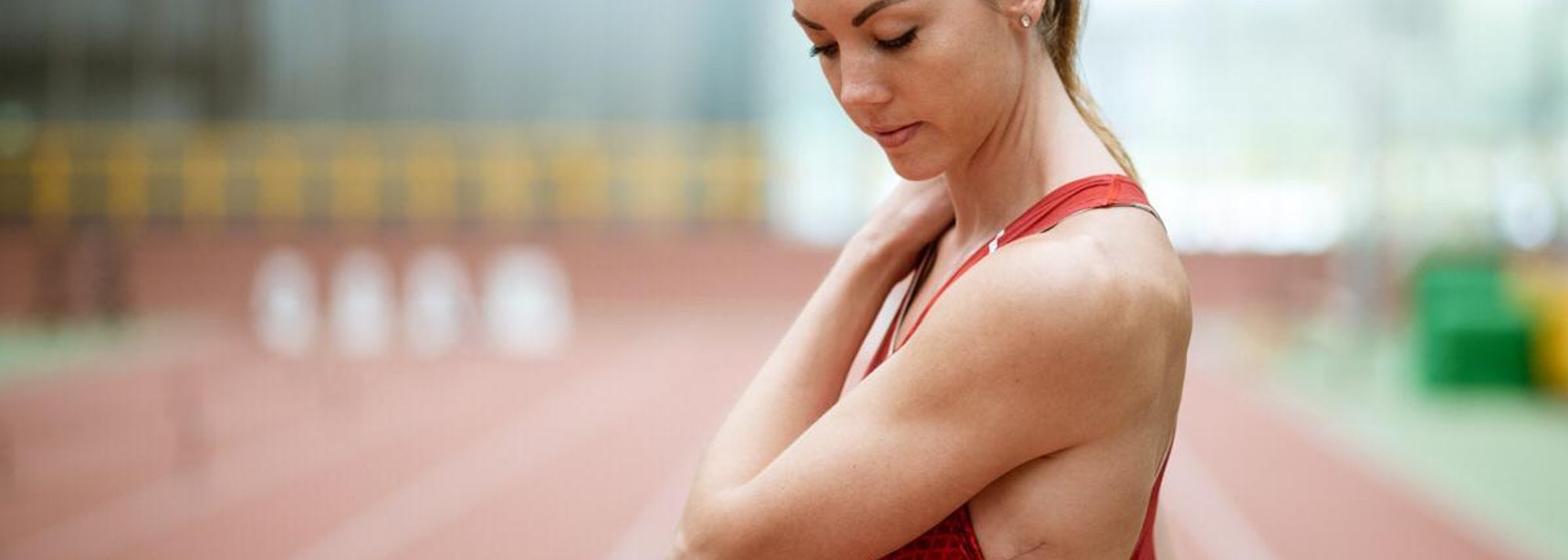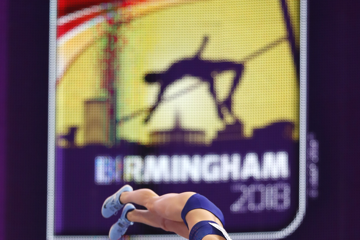Katharina Bauer shows the scar from her defibrillator surgery (© picture alliance)
First things first, let me introduce myself. My name is Katharina Bauer. I am 28-years-old. I am a pole vaulter and since 17 April 2018 I have a defibrillator fitted in my chest.
When I told my doctors I want to continue vaulting after the surgery they thought I was mad. Now I’m gradually proving that it is possible to be a professional athlete with a heart condition.
I’ve had heart problems since my early childhood. A healthy person has on average around 110,000 heartbeats per day. When I was seven years old, I already had about an extra 6000 heartbeats per day. In 2009 we tried to atrophy the part that was causing the extra heartbeats in a surgery, but that didn’t really work.
It’s never been particularly dangerous, and I never wanted to tell anyone other than those in my closest circle about it. But in 2017 we’d reached the point where I had an extra 18,000 heartbeats per day, which isn’t something you can just shrug off. That’s when I had to have heart surgery for a second time.
Initially it looked like it was working well. We got it down to about 3000 extra heartbeats a day, but after the outdoor season we were back up to 15,000. So here we were, discussing the possibility of another surgery. During the 2018 indoor season I won the German indoor title – which was huge for me and I went on warm weather training to South Africa after that. We had agreed to do a three-day ECG before heading out there and the examination showed that the number of extra heartbeats was still very high.
The other thing that showed on that last ECG was that we saw a different beat. I had felt it for about 10 years, but we could never pinpoint what exactly caused it. With that particular beat I would suddenly feel dizzy and think I’d pass out any minute, but nothing would ever happen, so I always remained fairly calm when it started. So suddenly that beat was on the ECG while I was vaulting, which for me was actually a relief because I thought “well if we can finally see it on there, it means we can finally operate on it.”
The thing is, this particular heartbeat is exactly the one that can cause ventricular fibrillation and lead to sudden cardiac death. That sounds scary, right?
The other problem with this beat is that it cannot be operated on. The only option to treat this symptom was to fit a defibrillator, so in case ventricular fibrillation does occur, its electrical impulse can save my life.
When I came back from South Africa, here I was left with not really an option other than to have a defibrillator fitted – at the age of 27. I found out one day, slept on it and made the decision to have it fitted. Five days later I was back in the operating theatre. Heart surgery number three.
I remember telling my doctors: “operate on me as soon as possible, we have a European Championships on home soil coming up.” They thought I was mad. But for me it was obvious: the quicker I can return to training, the sooner I can return to competition.
The hardest thing after the surgery was getting used to the feeling of having something in there. It felt like I was carrying a rock next to my heart. The defibrillator itself is about the size of my palm and weighs 300 grams. It sits right below the latissimus muscle – which you need when planting the pole. It’s the most important muscle for that, so I had no idea whether it would even be possible for me to vault. From the defibrillator itself, the electrode runs under the chest up to the collarbone, not attached to, but away from the heart.
The advantage of this particular hypodermic model is that it is specifically designed for younger patients and is much better for those who play sports. A lot of defibrillators would be externally fitted above the chest and the electrode would be connected to the heart, but if you’re a professional athlete and the electrode is connected to the heart, it could easily slip out of position and you could damage something from the inside. With this “younger” method, the electrode sits next to the heart and just lies around in there “sleeping” quietly in case anything does happen.
When they told me I needed a defibrillator, they were still intending to have another operation to reduce those extra heartbeats – the defibrillator alone can’t just get rid of them. But when we did another ECG two weeks after the operation it showed that the number of extra heartbeats had reduced from 15,000 to 2800 – without another surgery. I’m convinced mental training, hypnosis, and manipulating my self-regulating forces really helped with this.
I lined up in my first competition just six weeks post surgery and cleared 4.20m, which really surprised me. There aren’t any other professional athletes competing with a defibrillator, so I serve as somewhat of a guinea pig for the doctors.
Of course they are sceptical towards me pursuing this career. But they have always shown a lot of trust in me. They know I’ve always been a very positive person, very realistic, and they trust me with it. But in principle, no doctor in the world could say: “of course you can be a professional athlete with a defibrillator, that’s not a problem.”
However, I believe being an athlete really helped me cope with the situation. Your awareness for your body is amplified, the more you rely on it. As a professional athlete, you do pay more attention to your body. You notice finer nuances in how you feel, whether you’re well or unwell. And you have this whole network of people – doctors, physios – they check up on us on a regular basis.
The other thing is this fighter mentality you have as an athlete, to never give up, to work on your goals, to be determined in what you do and above everything, to believe in yourself. I want to push the envelope, that’s part of the appeal in sticking it out. The motivation in seeing how quickly you can make a return from injury – it’s the same as me trying to come back after that surgery.
It’s a matter of learning to deal with it and I am very pleased with how I’ve been getting on with it and have seen that it can work. What I couldn’t have imagined in my wildest dreams is that in only my second competition this indoor season I cleared the qualifying standard for the European Indoor Championships.
My last ECG was in December which showed I’m on about 3000 extra heartbeats per day. At the moment you can’t operate me because I am classed as healthy, which feels incredible to say. The defibrillator feels like a sort of safety net. Before it was fitted, I was 90 per cent confident everything was going to be okay. Now my confidence is way over 100 per cent.
Photography: picture alliance








